Read The Design of Everyday Things Online
Authors: Don Norman
The Design of Everyday Things (6 page)
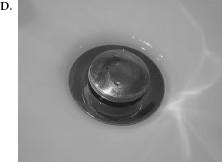
FIGURE 1.4.
  Â
The Sink That Would Not Drain: Where Signifiers Fail.
I washed my hands in my hotel sink in London, but then, as shown in Photo A, was left with the question of how to empty the sink of the dirty water. I searched all over for a control: none. I tried prying open the sink stopper with a spoon (Photo B): failure. I finally left my hotel room and went to the front desk to ask for instructions. (Yes, I actually did.) “Push down on the stopper,” I was told. Yes, it worked (Photos C and D). But how was anyone to ever discover this? And why should I have to put my clean hands back into the dirty water to empty the sink? The problem here is not just the lack of signifier, it is the faulty decision to produce a stopper that requires people to dirty their clean hands to use it. (Photographs by the author.)
Affordances, perceived affordances, and signifiers have much in common, so let me pause to ensure that the distinctions are clear.
Affordances represent the possibilities in the world for how an agent (a person, animal, or machine) can interact with something. Some affordances are perceivable, others are invisible. Signifiers are signals. Some signifiers are signs, labels, and drawings placed in the world, such as the signs labeled “push,” “pull,” or “exit” on doors, or arrows and diagrams indicating what is to be acted upon or in which direction to gesture, or other instructions. Some signifiers are simply the perceived affordances, such as the handle of a door or the physical structure of a switch. Note that some perceived affordances may not be real: they may look like doors or places to push, or an impediment to entry, when in fact they are not. These are misleading signifiers, oftentimes accidental but sometimes purposeful, as when trying to keep people from doing actions for which they are not qualified, or in games, where one of the challenges is to figure out what is real and what is not.
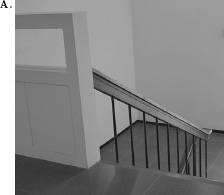
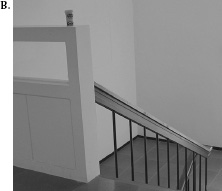

FIGURE 1.5.
  Â
Accidental Affordances Can Become Strong Signifiers.
This wall, at the Industrial Design department of KAIST, in Korea, provides an anti-affordance, preventing people from falling down the stair shaft. Its top is flat, an accidental by-product of the design. But flat surfaces afford support, and as soon as one person discovers it can be used to dispose of empty drink containers, the discarded container becomes a signifier, telling others that it is permissible to discard their items there. (Photographs by the author.)
My favorite example of a misleading signifier is a row of vertical pipes across a service road that I once saw in a public park. The pipes obviously blocked cars and trucks from driving on that road: they were good examples of anti-affordances. But to my great surprise, I saw a park vehicle simply go through the pipes. Huh? I walked over and examined them: the pipes were made of rubber, so vehicles could simply drive right over them. A very clever signifier, signaling a blocked road (via an apparent anti-affordance) to the average person, but permitting passage for those who knew.
To summarize:
      Â
â¢
 Â
Affordances are the possible interactions between people and the environment. Some affordances are perceivable, others are not.
      Â
â¢
 Â
Perceived affordances often act as signifiers, but they can be ambiguous.
      Â
â¢
 Â
Signifiers signal things, in particular what actions are possible and how they should be done. Signifiers must be perceivable, else they fail to function.
In design, signifiers are more important than affordances, for they communicate how to use the design. A signifier can be words, a graphical illustration, or just a device whose perceived affordances are unambiguous. Creative designers incorporate the signifying part of the design into a cohesive experience. For the most part, designers can focus upon signifiers.
Because affordances and signifiers are fundamentally important principles of good design, they show up frequently in the pages of this book. Whenever you see hand-lettered signs pasted on doors, switches, or products, trying to explain how to work them, what to do and what not to do, you are also looking at poor design.
AFFORDANCES AND SIGNIFIERS: A CONVERSATION
A designer approaches his mentor. He is working on a system that recommends restaurants to people, based upon their preferences and those of their friends. But in his tests, he discovered that people never used all of the features. “Why not?” he asks his mentor.
(With apologies to Socrates.)
DESIGNER | MENTOR |
I'm frustrated; people aren't using our application properly. | Can you tell me about it? |
The screen shows the restaurant that we recommend. It matches their preferences, and their friends like it as well. If they want to see other recommendations, all they have to do is swipe left or right. To learn more about a place, just swipe up for a menu or down to see if any friends are there now. People seem to find the other recommendations, but not the menus or their friends? I don't understand. | Why do you think this might be? |
I don't know. Should I add some affordances? Suppose I put an arrow on each edge and add a label saying what they do. | That is very nice. But why do you call these affordances? They could already do the actions. Weren't the affordances already there? |
Yes, you have a point. But the affordances weren't visible. I made them visible. | Very true. You added a signal of what to do. |
Yes, isn't that what I said? | Not quiteâyou called them affordances even though they afford nothing new: they signify what to do and where to do it. So call them by their right name: |
Oh, I see. But then why do designers care about affordances? Perhaps we should focus our attention on signifiers. | You speak wisely. Communication is a key to good design. And a key to communication is the signifier. |
Oh. Now I understand my confusion. Yes, a signifier is what signifies. It is a sign. Now it seems perfectly obvious. | Profound ideas are always obvious once they are understood. |
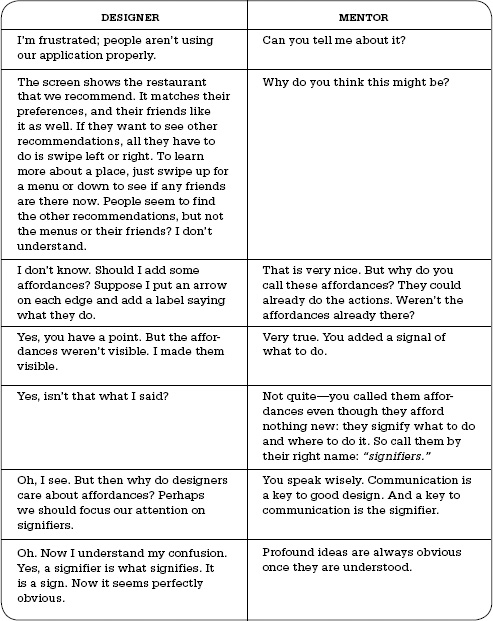
MAPPING
Mapping is a technical term, borrowed from mathematics, meaning the relationship between the elements of two sets of things. Suppose there are many lights in the ceiling of a classroom or auditorium and a row of light switches on the wall at the front of the
room. The mapping of switches to lights specifies which switch controls which light.
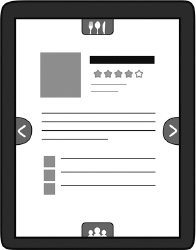
FIGURE 1.6.
  Â
Signifiers on a Touch Screen.
The arrows and icons are signifiers: they provide signals about the permissible operations for this restaurant guide. Swiping left or right brings up new restaurant recommendations. Swiping up reveals the menu for the restaurant being displayed; swiping down, friends who recommend the restaurant.
Mapping is an important concept in the design and layout of controls and displays. When the mapping uses spatial correspondence between the layout of the controls and the devices being controlled, it is easy to determine how to use them. In steering a car, we rotate the steering wheel clockwise to cause the car to turn right: the top of the wheel moves in the same direction as the car. Note that other choices could have been made. In early cars, steering was controlled by a variety of devices, including tillers, handlebars, and reins. Today, some vehicles use joysticks, much as in a computer game. In cars that used tillers, steering was done much as one steers a boat: move the tiller to the left to turn to the right. Tractors, construction equipment such as bulldozers and cranes, and military tanks that have tracks instead of wheels use separate controls for the speed and direction of each track: to turn right, the left track is increased in speed, while the right track is slowed or even reversed. This is also how a wheelchair is steered.
